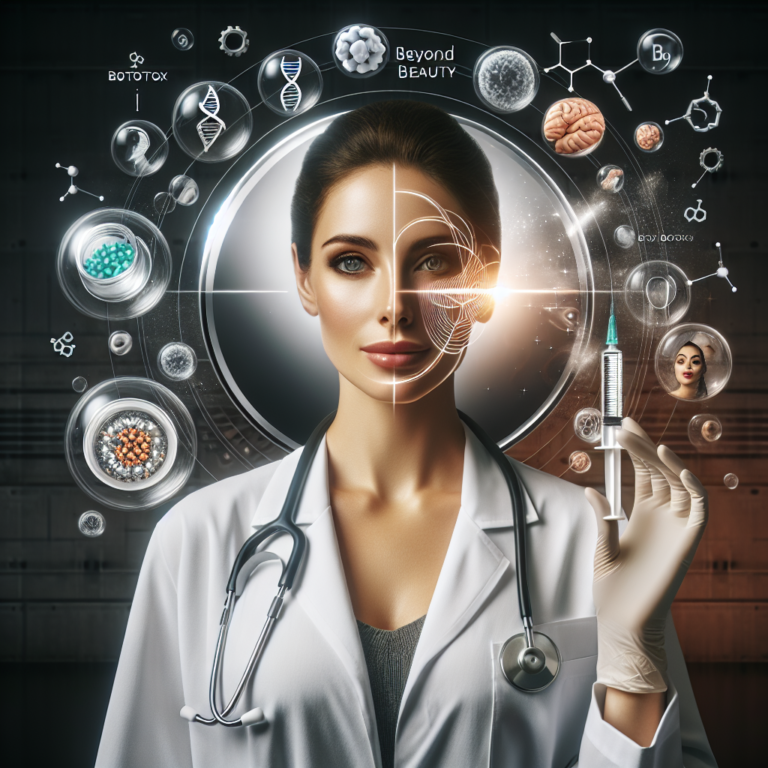Beyond Beauty: The Future of Botox in Medical Treatments and Aesthetics
For decades, Botox—a brand name for botulinum toxin type A—has been primarily synonymous with cosmetic enhancement. Commonly used to reduce the appearance of fine lines and wrinkles, Botox has solidified its status in the aesthetics industry. However, a broader perspective reveals that the future of Botox goes far beyond its cosmetic applications. As research continues to unveil its therapeutic potential, the world is beginning to recognize Botox as a multifaceted tool in medical treatments and aesthetics alike.
The Origins of Botox
Botox was first approved by the U.S. Food and Drug Administration (FDA) in the late 1980s for the treatment of strabismus (crossed eyes) and blepharospasm (uncontrolled blinking). Its muscle-relaxing properties quickly gained attention, leading to its emergence as an effective solution for various medical conditions. The FDA later approved its use for conditions ranging from chronic migraines to excessive sweating (hyperhidrosis), highlighting its versatility.
Expanding Medical Applications
Recent advancements in research are pushing the boundaries of Botox beyond its already established medical applications. Some of the most promising directions include:
-
Chronic Pain Management: Studies have shown that Botox can provide significant relief for conditions such as neuropathic pain and temporomandibular joint (TMJ) disorders. By inhibiting the release of pain signaling molecules, Botox can effectively disrupt pain pathways, offering patients a non-invasive alternative for pain management.
-
Neurological Disorders: There is a growing interest in using Botox for various neurological conditions, including multiple sclerosis and cerebral palsy. Researchers are exploring its potential to reduce spasticity and improve overall quality of life for affected individuals.
-
Mental Health: Intriguingly, recent studies suggest that Botox may have a role in treating mental health conditions such as depression and anxiety. The "facial feedback hypothesis" posits that our facial expressions can influence our emotions. By paralyzing specific facial muscles associated with frowning, Botox could help alleviate symptoms of depression, providing a novel and compelling avenue for treatment.
- Gastrointestinal Disorders: Botox injections are increasingly being explored for treating gastrointestinal issues such as gastroparesis (delayed stomach emptying) and esophageal achalasia (difficulty swallowing). By relaxing muscles and reducing spasms in the digestive tract, Botox offers a potential option for patients suffering from these challenging conditions.
Aesthetic Evolution
In the realm of aesthetics, the application of Botox is evolving as well. Patients today are seeking more natural and subtle results, shifting the paradigm from drastic transformation to enhancement. This movement emphasizes the use of "tweakments"—subtle adjustments that maintain the patient’s authentic appearance while softening undesirable features.
-
Preventative Treatments: An increased focus on preventive aesthetic treatments is reshaping the demographic of Botox users. Younger individuals are turning to Botox as a preventive measure, aiming to delay the onset of fine lines and wrinkles. This trend reflects a growing awareness of skincare and aesthetics that prioritizes long-term results.
-
Combination Therapies: The integration of Botox with other treatments—including dermal fillers, laser therapies, and skincare regimens—creates a holistic approach to aesthetic enhancement. This combination not only maximizes results but also allows practitioners to tailor treatments to meet the unique needs of each patient.
- Regenerative Aesthetics: There is a burgeoning interest in combining Botox with regenerative approaches, such as platelet-rich plasma (PRP) therapy. This innovative pairing could amplify results, as PRP aids in skin rejuvenation while Botox addresses muscle activity, ultimately promoting healthier skin.
Ethical Considerations and Industry Evolution
With the expanding range of Botox applications, ethical considerations and industry standards must evolve. The rise of medical aesthetics has led to an increased demand for qualified practitioners. Ensuring that Botox is administered safely and effectively requires a rigorous emphasis on training and adherence to best practices.
Additionally, as the stigma surrounding cosmetic procedures diminishes, societal attitudes toward aesthetic enhancement continue to shift. Public discussions about body positivity and self-acceptance are intersecting with the quest for aesthetic improvement, prompting a reevaluation of how such treatments are perceived.
Conclusion
As the narrative around Botox transforms, we stand on the cusp of a revolution in both medical treatments and aesthetics. With ongoing research unveiling its diverse applications, Botox is poised to become a cornerstone in various therapeutic approaches, while also adapting to the evolving demands of aesthetic enhancement. The future of Botox promises not only an expansion of its medical utility but also a redefined standard of beauty—emphasizing natural results and holistic care. As we look forward, it is clear that Botox is more than a beauty treatment; it is a catalyst for change in how we approach health and aesthetics.


